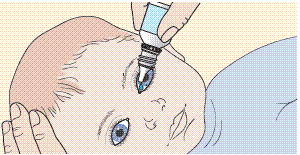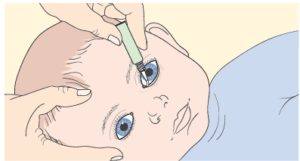How to give medicines: eye drops and eye ointment
This leaflet has been specifically written about how to give eye drops and eye ointment to children. Please read this leaflet carefully. Keep it somewhere safe so that you can read it again. Specific information on individual medicines is available on the Medicines Information pages.
This page explains how to give eye drops and eye ointment to children. Read the information or watch the video all the way to the end before doing this for the first time.
Eye drops and eye ointment
Medicines for the eye are available as eye drops or as eye ointment.
Important things to know about eye drops and eye ointment
- Once opened, eye drops and ointments should not normally be kept more than 28 days. Give old medicines to your pharmacist to dispose of.
- Sometimes eye drops or ointment can cause mild redness, stinging or blurred vision. This should go away after a few minutes. If it persists or is severe, contact a doctor or pharmacist.
- Your child should not wear contact lenses during the course of treatment with eye drops or ointment.
- If your child is using more than one eye medicine, wait at least 5 minutes between giving the different medicines.
- If your child is being treated for an eye infection, it is common to be given a separate bottle or tube for each eye.
Eye drops
Before you give eye drops
- If you have to give both eye drops and eye ointment, give the eye drops first and then the ointment
- Use the eye drops only in the infected eye, unless your doctor has told you to treat both eyes.
- Wash your hands thoroughly with soap and hot water before and after giving the drops.
- The drops are easiest to give when your child is lying down.
How to give eye drops
- It is important for your child to be still whilst you give eye drops. You may need help from another adult, especially with small children and babies. One of you can hold your child still and reassure them, while the other gives the drops.You may find it helpful to wrap a small child or baby in a blanket to help keep them still.
- For older children, gently pull the lower lid out and squeeze the bottle gently so that one drop goes into the pocket that is formed.
.png)
 In small children and babies, place the drop into the inner corner of the eye. This is easier with the eye open, but the liquid will still drain on to the eye even with a closed eye if you can hold your child’s head still for a few seconds.
In small children and babies, place the drop into the inner corner of the eye. This is easier with the eye open, but the liquid will still drain on to the eye even with a closed eye if you can hold your child’s head still for a few seconds.- Hold the bottle as reasonably close to the eye as possible, without the tip touching your child’s eye.
.png)
- After giving eye drops, your child should keep their eye closed for as long as they can (5 seconds if possible) so that the eye drop doesn’t spill out.
- If you think the drop didn’t go into the eye, you can repeat the process but do not try more than twice.
- Try to avoid the tip of the tube touching any part of your child’s eye, if possible.
- Wash your hands again with soap and hot water.
Eye ointment
Before you give eye ointment
- If you have to use both eye drops and eye ointment, use the eye drops first and then apply the ointment
- Use the eye ointment only in the infected eye, unless your doctor has told you to treat both eyes.
- Wash your hands thoroughly with soap and hot water before and after giving the ointment.
- The ointment is easiest to give when your child is lying down.
How to give eye ointment
- For older children, gently pull the lower lid out and down and squeeze the tube gently so that a small amount (approximately 1 cm) goes into the pocket that is formed.

 In small children and babies, place the ointment into the inner corner of the eye, preferably with the eye open.
In small children and babies, place the ointment into the inner corner of the eye, preferably with the eye open.
.png)
- After giving the ointment, your child should blink several times to help dissolve the ointment.
- If you think the ointment didn’t go into the eye, you can repeat the process but do not try more than twice.
- Try to avoid the tip of the tube touching any part of your child’s eye, if possible.
- Wash your hands again with soap and hot water.
Who to contact for more information
Your child’s doctor, pharmacist or nurse will be able to give you more information about your child’s medicine.
You can read further information about individual medicines by searching (A-Z) on the Medicines Information pages on this website.
